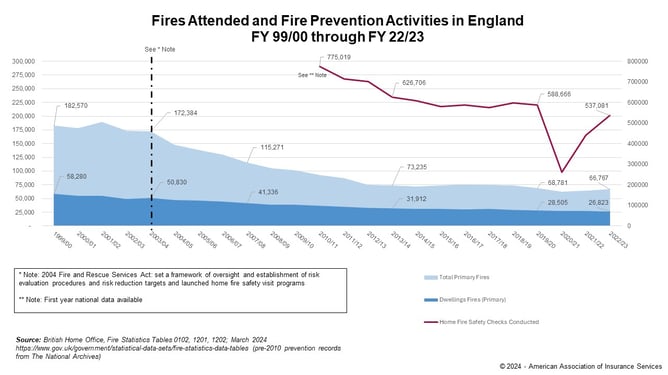Over the past decade, there has been a new paradigm emerging in the American fire service. This paradigm shift is often referred to as Community Risk Reduction, or simply CRR. The genesis of this change comes from the British fire service, where in the early 2000s the central government mandated that local fire services meet challenging fire reduction targets or face substantial budget cuts. These fire reduction targets were initially dismissed as absurd by fire personnel who had seen limited success in their legacy fire prevention efforts and assumed people were going to continue to make bad choices and fires would continue to happen unabated. However, given that they were facing potentially daunting cuts, the fire services across the UK got creative. They figured out what strategies actually worked, and they started seeing substantial reductions in fires countrywide. What they originally dismissed as absurd ended up turning into a nearly 60% reduction in the total number of fires across the country and nearly a 40% reduction in primary dwelling fires[i] over the initial ten-year period. Meanwhile, during that same period, according to the NFPA’s annual fire loss reports, the number of fire incidents in the U.S. remained largely unchanged[ii].

Following the success of this model, several fire departments across North America began to develop similar mitigation strategies that were focused, coordinated, and ultimately effective in reducing fire and other emergency incidents in their communities. Surrey Fire Service in British Columbia, Canada used similar principles to reduce fire incidents by 80% in a 12-year period[iii], and Kankakee Fire Department in Illinois reduced fires in their focus area by 40% over several years[iv]. So, it raises the question, why doesn’t every local fire department embrace CRR if it promises such significant potential reductions in losses?
Have We Created a Moral Hazard by Incentivizing the Wrong Things?
A large part of the answer to that question rests in the fact that most of what we measure, and thus incentivize fire departments to focus on, tends to be response oriented. What has been missing from this equation for far too long is any meaningful evaluation of how good of a job our communities and the fire departments that protect them are doing in terms of reducing risk, not just responding to it. Frankly, it is far easier for fire departments to largely ignore proactive risk mitigation strategies and take a more reactive suppression-focused approach. Doing “the right thing” in terms of executing effective CRR programs takes time, effort, passion, and money.
There is little if any incentive for fire departments to take this CRR paradigm shift seriously. To put it in more stark terms, we have created a Moral Hazard where we inadvertently reward all of the wrong things, and thus we should not be surprised that CRR efforts are given short shrift. So, to answer the question of “Why don’t more fire departments embrace CRR?”, it is because the way we grade and evaluate fire departments doesn’t meaningfully evaluate CRR. For CRR to become more than just the “right thing to do,” we need to put CRR front and center in how we evaluate public fire protection…and that’s exactly what AAIS is doing.
AAIS’s Role: FLAMES
Each community is different, faces different risks, and needs different interventions. Yet, it is challenging to develop a standardized and consistent way to objectively measure how well a community is doing in terms of understanding its various risks, developing meaningful strategies to reduce those risks, and measuring the effectiveness of their efforts, at scale. AAIS has developed a novel approach to rating modern public fire protection called FLAMES (Fire Loss and Mitigation Evaluation Score). FLAMES challenges the legacy assumptions that limit modern insurers’ ability to accurately select and price risk by turning the focus from counting response equipment to evaluating mitigation effectiveness.
Building upon this existing filed approach, AAIS is expanding and enhancing its fire loss model countrywide to give insurers a more granular and accurate understanding of fire losses. AAIS is also developing an innovative methodology for evaluating local mitigation efforts where they are the most effective: at the local level. This approach will provide insurers and communities with important insights about the effectiveness of local mitigation programs and services in a market constantly disrupted by ever-increasing losses.
To learn more about what’s to come with the FLAMES initiative, visit AAISonline.com or contact an AAIS Engagement Manager.
[i] British fire services classify fires as either primary fires, the most severe, or secondary fires, which pose less immediate risk to life or property. They also break out dwellings fires out of the wider statistics about primary fires. These statistics were compiled from data publicized by the British Home Office.



